A) $0.
B) $50,000.
C) $60,000.
D) $110,000.
Correct Answer

verified
Correct Answer
verified
Multiple Choice
Refer to the information provided in Figure 7.4 below to answer the questions that follow. 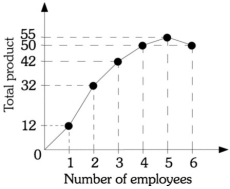 Figure 7.4
-Refer to Figure 7.4. Diminishing marginal returns begin when the ________ worker is hired.
Figure 7.4
-Refer to Figure 7.4. Diminishing marginal returns begin when the ________ worker is hired.
A) first
B) second
C) third
D) fifth
Correct Answer

verified
Correct Answer
verified
Multiple Choice
Refer to the information provided in Figure 7.12 below to answer the questions that follow. 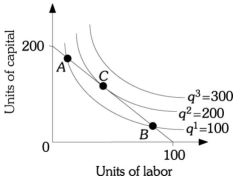 Figure 7.12
-Refer to Figure 7.12. If the firm's level of total cost is represented by the given isocost line, the firm's optimal combination of capital and labor is given by
Figure 7.12
-Refer to Figure 7.12. If the firm's level of total cost is represented by the given isocost line, the firm's optimal combination of capital and labor is given by
A) point A.
B) point B.
C) point C.
D) 50 units of capital and 50 of labor.
Correct Answer

verified
Correct Answer
verified
Multiple Choice
Refer to Scenario 7.3 below to answer the questions that follow. SCENARIO 7.3: Upon graduating with an accounting degree, you open your own accounting firm of which you are the sole employee. To start the firm you passed on a job offer with a large accounting firm that offered you a salary of $60,000 annually. Last year you earned a total revenue of $100,000. Rent and supplies last year were $50,000. -Refer to Scenario 7.3. Your annual economic profit is
A) -$10,000.
B) $40,000.
C) $50,000.
D) $100,000.
Correct Answer

verified
Correct Answer
verified
Multiple Choice
Refer to the information provided in Figure 7.9 below to answer the questions that follow. 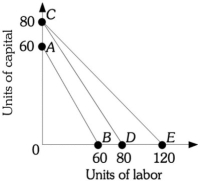 Figure 7.9
-Refer to Figure 7.9. The firm's isocost line would shift from CD to CE if
Figure 7.9
-Refer to Figure 7.9. The firm's isocost line would shift from CD to CE if
A) the price of capital fell.
B) the firm's total expenditure on inputs increased.
C) the price of labor fell.
D) either the price of labor fell or the firm's total expenditure on inputs increased.
Correct Answer

verified
Correct Answer
verified
Multiple Choice
Refer to the information provided in Figure 7.4 below to answer the questions that follow.  Figure 7.4
-Refer to Figure 7.4. The average product of the sixth worker is
Figure 7.4
-Refer to Figure 7.4. The average product of the sixth worker is
A) -8.33.
B) -5.
C) 5.
D) 8.33.
Correct Answer

verified
Correct Answer
verified
Multiple Choice
Refer to the information provided in Figure 7.12 below to answer the questions that follow.  Figure 7.12
-Refer to Figure 7.12. At Point C, the slope of isoquant q2 = 200 is
Figure 7.12
-Refer to Figure 7.12. At Point C, the slope of isoquant q2 = 200 is
A) -2.
B) -1/2.
C) -1.
D) indeterminate from this information.
Correct Answer

verified
Correct Answer
verified
Multiple Choice
The optimal method of production is the one that
A) maximizes output regardless of cost.
B) maximizes inputs.
C) minimizes cost.
D) minimizes the normal rate of return.
Correct Answer

verified
Correct Answer
verified
Multiple Choice
Use the information provided in Table 7.1 below to answer the questions that follow. Table 7.1 Inputs Required to Produce a Product Using Alternative Technologies -Refer to Table 7.1. If the hourly wage rate is $10 and the hourly price of capital is $25, which production technology should be selected?
A) A
B) B
C) C
D) D
Correct Answer

verified
Correct Answer
verified
Multiple Choice
Perfectly competitive firms must make all of the following decisions EXCEPT
A) how much output to supply.
B) which production technology to use.
C) how much of each input to demand.
D) what price to charge for its output.
Correct Answer

verified
Correct Answer
verified
True/False
For economic analysis, the short run is considered less than one year.
Correct Answer

verified
Correct Answer
verified
Multiple Choice
Costs of production are determined
A) only by the technologies that are available.
B) only by the input prices that are available.
C) by the technologies that are available and by input prices.
D) by the technologies that are available and by the demand for the output.
Correct Answer

verified
Correct Answer
verified
Multiple Choice
Refer to Scenario 7.4 below to answer the questions that follow. SCENARIO 7.4: A lawn service company has the following production possibilities. With one, two, three, and four workers, the company can mow 4, 9, 12, and 14 lawns per day, respectively. -Refer to Scenario 7.4. The marginal product of the third worker is
A) 2
B) 3
C) 4
D) 12
Correct Answer

verified
Correct Answer
verified
Multiple Choice
Refer to the information provided in Figure 7.11 below to answer the questions that follow. 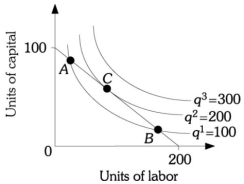 Figure 7.11
-Refer to Figure 7.11. If this firm's cost of capital is $20 per unit and its cost of labor is $10 per unit, the isocost line represents a total cost of
Figure 7.11
-Refer to Figure 7.11. If this firm's cost of capital is $20 per unit and its cost of labor is $10 per unit, the isocost line represents a total cost of
A) $2,000.
B) $3,000.
C) $4,000.
D) $8,000.
Correct Answer

verified
Correct Answer
verified
Multiple Choice
Isoquants are downward sloping because
A) as more units of an input are used to produce a product, total cost increases.
B) as more units of an input are used to produce a product, the firm's marginal productivity increases.
C) if more of one input is used, then less of the other input must be used to keep output constant.
D) Both B and C
Correct Answer

verified
Correct Answer
verified
Multiple Choice
Refer to the information provided in Figure 7.6 below to answer the questions that follow. 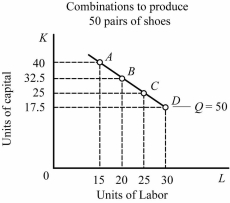 Figure 7.6
-Refer to Figure 7.6. The shoe manufacturer currently produces 50 units of output. If this shoe manufacturer increases labor from 15 to 20, the marginal product of the 20th worker
Figure 7.6
-Refer to Figure 7.6. The shoe manufacturer currently produces 50 units of output. If this shoe manufacturer increases labor from 15 to 20, the marginal product of the 20th worker
A) is zero, as the total number of shoes produced remains at 50.
B) is 8.5, as capital can be reduced by 8.5 units when the 20th worker is hired.
C) cannot be determined because output remains constant.
D) cannot be determined because both capital and labor have been increased.
Correct Answer

verified
Correct Answer
verified
Multiple Choice
Refer to the information provided in Figure 7.8 below to answer the questions that follow. 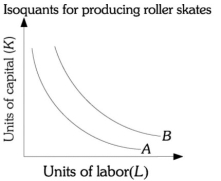 Figure 7.8
-Refer to Figure 7.8 above. If Roller Skates Unlimited moves from isoquant B to isoquant A, the number of roller skates produced
Figure 7.8
-Refer to Figure 7.8 above. If Roller Skates Unlimited moves from isoquant B to isoquant A, the number of roller skates produced
A) decreases.
B) increases.
C) remains constant, but Roller Skates Unlimited uses more capital and more labor.
D) remains constant, but input prices have risen.
Correct Answer

verified
Correct Answer
verified
Multiple Choice
The least costly way to produce any given level of output is indicated by
A) the point of intersection between the isoquant corresponding to that level of output and the Y-axis.
B) the point of intersection between the isoquant corresponding to that level of output and the X-axis.
C) the point of tangency between an isocost line and the isoquant corresponding to that level of output.
D) the isocost line corresponding to that level of output.
Correct Answer

verified
Correct Answer
verified
Multiple Choice
Refer to the information provided in Figure 7.3 below to answer the questions that follow. 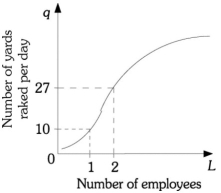 Figure 7.3
-Refer to Figure 7.3. The average product of the second worker is ________ yards raked.
Figure 7.3
-Refer to Figure 7.3. The average product of the second worker is ________ yards raked.
A) 4
B) 13.5
C) 14
D) 27
Correct Answer

verified
Correct Answer
verified
Multiple Choice
Refer to the information provided in Figure 7.9 below to answer the questions that follow.  Figure 7.9
-Refer to Figure 7.9 The firm's isocost line could shift from CD to AB if
Figure 7.9
-Refer to Figure 7.9 The firm's isocost line could shift from CD to AB if
A) the price of capital increased.
B) the firm's total expenditures increased by 25%.
C) the price of capital and labor each increased by 25%.
D) the firm's total expenditures decreased by 25% or the price of capital and labor each increased by 33%.
Correct Answer

verified
Correct Answer
verified
Showing 101 - 120 of 144
Related Exams